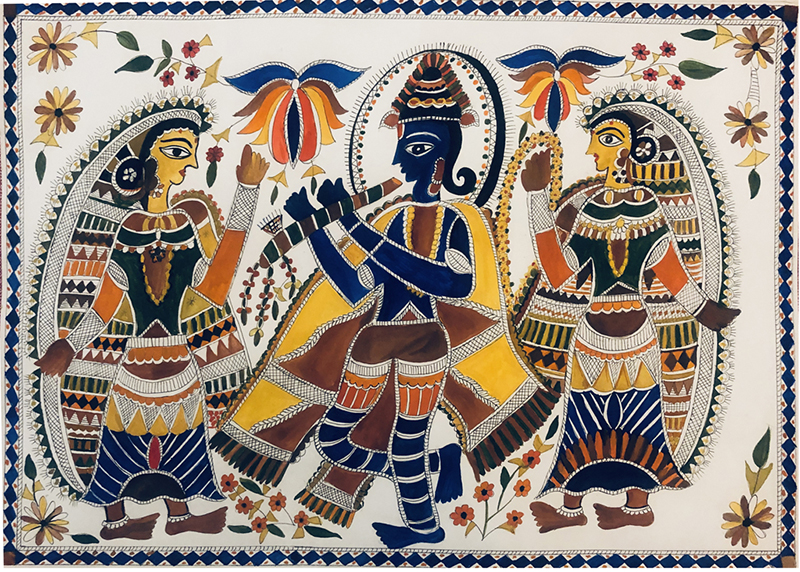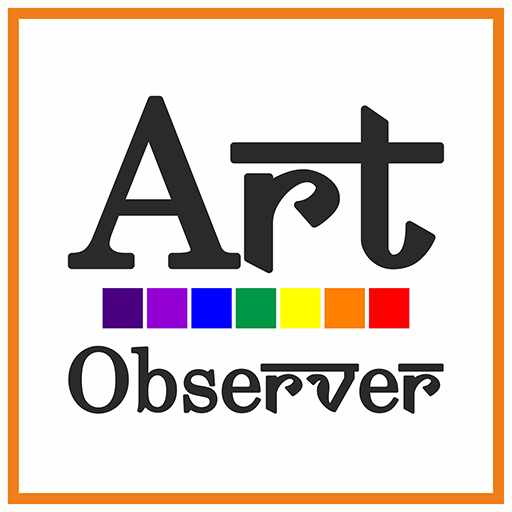India is a diverse country characterised by distinct languages, and rich cultural traditions. The folk and tribal arts of India express the cultural diversity of the country and provide a window through which one can explore the rich heritage.
“Indian Folk Art” dates back to a period that may be referred to as “timeless”. Folk and tribal painting come from the remote rural and tribal regions. The various painting forms coming from these regions began not just as a painting but also as a religious ritual performed daily. It began with painting the walls and floor of mud houses. Various religions and symbols are also seen within the painting.
Folk art is the art created among groups that exist within the framework of existing society, but, for geographical and cultural reasons, are largely separated from the sophisticated developments of time. As a result, they produce distinctive styles and objects for local needs and tastes. In folk tradition, art is nourishment to the daily life of the people. Whether he is a potter from Tamilnadu, who creates a massive terracotta or a tribal from Madhya Pradesh who creates Pithora” painting, geography has control over the medium of art. In the case of Uttar Pradesh and Bihar we can find folk paintings on the walls of the houses. In this regard, artist-writer, Haku Shah writes, “When a tribal touch a blade of grass, gourd or bead, fibre, twig, grain, pin, plastic button, conch shell, feather, leaf of flower, he sees through it, smells it, hears it, and therein starts the ritual of being with it.” Each part of India with it’s own trees and plants, birds and animals, has inspired Indian folk artists to have multiple metaphors, series of symbols and innumerable images to build a rich treasure-house of art.


Disclaimer
The views expressed in the different features and articles and news in Art Observer are entirely and exclusively those of the contributor/artist. Art Observer on its part, does not agree/disagree/subscribe to the same, in any way and to any extent.
© Shanker Art Foundation
No content of the newspaper – ‘ART OBSERVER’ and websites ‘ARTinfoINDIA.COM, ‘ChildrenArtContest.COM & ArtObserver.IN shall be published or borrowed without the knowledge and consent of the OWNER / SHANKER ART FOUNDATION and all profits from any means shall directly be the property of SHANKAR ART FOUNDATION
Explore
- Articles
- Visual of the Month
- All Issues
- Volume 2 Issue 1Without dampening their spirits, ready to face any situation and work ceaselessly, the artists have been fighting fit. The virtual shows, conferences and workshops have given another angle to today’s showbiz. ‘Art Observer’ has interacted with many artists, art-teachers, writers and students who are working hard to overcome all the hurdles and keep the flag of creativity high. It was a matter of great pride for all the artists and well wishers of Roop Chand to attend an informal award giving ceremony at the National Art Centre, Gurgaon when the senior artist was personally awarded by Dr. Sanjay Gupta, the Vice Chancellor of World University of Design. An article on Victoria Memorial will take you along to witness the heritage of our country. Such masterpieces of the past always make us proud and throw light on the dedication of creators. Professor D. S. Kapoor’s detailed information on the prestigious institutions of design can help many aspiring students to find their track. His information on Art Colleges, provided in the July issue was highly commended. We Hope this article proves to be equally helpful if not more. Artists’ imagination can take any direction and why not! Yes, using coffee as a…
- Volume 1 Issue 7COVID 19 has put everything out of gear and what was never imagined before has appeared in front of us as a giant. Artist community has not been spared. Artists being super-sensitive, having bare nerves deal with life in their own unique manner. This issue of Art Observer has covered that largely. ‘Art is Life’ shares viewing experience of many galleries and collaboration with museums overseas bringing eminent personalities in forefront. Rajesh Sarovar, a Kerala based artist has studied the human struggle for existence in his own larger than life display infused with colours. An article on his work is a story of artist’s journey as well. We share with you how the works of nine Bangladeshi artists launched by The Durjay Bangladesh Foundation have not only gone global but also share role of the art in dispelling the fear and anxiety in uncertain times. Art Observer has displayed the unique embroideries of Anuradha Bhaumik as well as the classical art of Tanjore painting with all the details on themes and techniques. Michelle Poonawala’s show at Tao Art Gallery, Mumbai was the first post COVID exhibition covered by Subhra Majumdar in this issue. Both online and physical visit have added…
- Volume 1 Issue 6The COVID-19 pandemic has necessitated a rethinking of our work schedules. The uncertainty of things happening has added to the panic that is making it difficult to lead a normal life. An artist already known to be super sensitive needs to save his raw nerves more cautiously. No wonder most of the artists are diverting all their energy to creativity. We are receiving the pictures of amazingly wonderful works done by artists from different parts of India. Understanding well that it is not possible to exhibit the works in galleries in such difficult days, we at Art Observer believe in giving full moral support to the artists to keep them going. For many it has become almost therapeutic and we appreciate the outpour that is honest, brilliant and vibrant. Art works of some artists are full of expression and style of execution. Falguni without being symbolic or philosophical, has dealt with the contemporary theme very directly that is as good as recording in a diary. Readers are sure to enjoy the diversity of styles in all these works by the artists. Dr D S Kapoor, an eminent artist and educationist has very laboriously guided the young generation to understand the…
- Volume 1 Issue 5There is a very thin line between the Visual Arts and the Performing Arts. In fact these arts complement each other and are well integrated. This issue presents an exceptionally talented, classical dancer, the creator of Sufi Kathak, Manjari Chaturvedi. ‘In the Conversation’, this artist shares how her struggle to achieve her goal made her realise that ‘it is good to have an end to journey towards; but it is the journey that matters in the end’. Readers will enjoy to read about the synthesis of grace, calm and sensuality. Mother nature’s palette is a rich source of inspiration for any artist. When a colour dominates in the imagination of a creator, it’s bound to reappear on the canvas and envelope the viewer. An article ‘Plants on Canvases’ by Pooja Gupta is all about the nature’s beauty mingling with the colours. What lies in a title is an in-depth study of thematic content of any piece of art by Simret Singh. ’Rang Matir Pachali’ is another article that takes us on a trip to an unusual exhibition during these days of lockdown. Shanker Art Foundation’s deep concern for the creativity among children has encouraged a huge participation of young ones…
- Volume 1 Issue 4Dear Reader, Now that Corona does not seem to be leaving us that soon, the lifestyle of most of us has changed. Already restricted movement has compelled everyone to look within and utilise the time for creativity. We are getting good responses from many artists who are able to devote more time to their art and share with us. Our experienced contributors are giving details on art forms, trends and the psychology of artists behind. Sitting at home you can enjoy the history and visuals of some rare museums and galleries. Article on Thakur Bari will take you to the times when talented members of the Tagore family made it part of Art history. A write up on the ultimate artist Roop Chand mentions his vast and varied works, his humanism that speaks of his multifaceted genius. A journey that was not easy but has no regrets. Enjoy reading !
- Volume 1 Issue 3The opening article of this issue is a tribute to Satish Gujral, a legend whose life was not a normal journey but he set milestones of destination at every bend of road. There can never be another artist like him, an institution in himself. The ‘Real’ in painting – an essay deals with thematic and stylistic presentations following norms of art principles understanding artists’s imaginative consciousness. ‘Ghare Baire’ an exceptional Art Museum in Kolkata is a real treat to be shared with the readers and so is the Sweden’s TellusArt Residency at a village in Uttarakhand. ‘WOW (white on white) show’ forcefully displays mono colour challenges expressing less is more. In Suryastnata Mohanty’s words there is the possibility of seeing all colours in white. It takes us closer to Physics dealing with light. In these trying times, Corona warriors are doing their best to make the country Corona free. The lockdown period has not been easy for anyone, but artists sometimes give their best under stress. Here, we share some of the works of artists from different cities who are working in the grip of Corona and talk about their creativity and experiences. Another article on Child Art also mentions…
- Volume 1 Issue 2Art Observer is dedicated to the wide spectrum of visual and performing arts. Efforts have been to share and showcase aesthetically appealing creations to all the ‘rasiks’. This journal is also a platform for the aspiring and talented artists to reveal their works and express their views. This issue has covered some prestigious, innovative and inspiring exhibitions that have made a mark. The National Kala Mela 2020 held at Lalit Kala Akademi, New Delhi, exhibition of renowned artists at Sanchit Art, New Delhi, An unusual exhibition of thread work – ‘Bakhiya’ that has symbolised the Sufi meditative activity compels us to look within and start embracing imperfection in day to day life. A very laborious task of organising exhibition of painted masks by Speaking Art Foundation familiarises us with the diversity in theme-Shakti. This exhibition of 200 masks was held at Lokayata, New Delhi. Breathtakingly beautiful and candid works of Idris are revealing the dedication of a photographer trying to freeze the images in time. Mahmood Ahmad’s transformation from vibrant landscapes in acrylic to drawings of female form in black and white is stunning indeed. One always likes to read about the great masters and learn from their experiences on…
- Volume 1 Issue 1Dear reader, If India is one of the youngest nations as per number of youngsters in population, let us not ignore the number of creative young minds and hands all set to express. No wonder art galleries are mushrooming all over, particularly in the bigger cities. Many art lovers are not gallery hoppers and we feel, Art that is well presented is better enjoyed and it must reach the true ‘Rasik’. Art Observer is one such step in the same direction. We feature a potpourri of art, artists from past and present, art patrons and art institutions that have created history. Our gallery-trotting contributors have covered The India Art Fair 2020, India-Bangladesh Printmaking Exhibition, Art Fair Spain and many new and notable works, exhibitions and events. One of the oldest art galleries in Delhi- Dhoomimal has its own rich history that Mohit Jain has shared in conversation. Old masters’ works have a lot to inspire, be it Joan Miró’s sparks on canvas or Swaminathan’s spiritual journey through colour and canvas. An ancient Institution with glorious heritage has been well worded by D S Kapoor. In this promising year 2020, we can’t ignore the younger generation and feel highly responsible to…
- Art Happenings
- Contemporary Personalities
- Tools and Techniques
